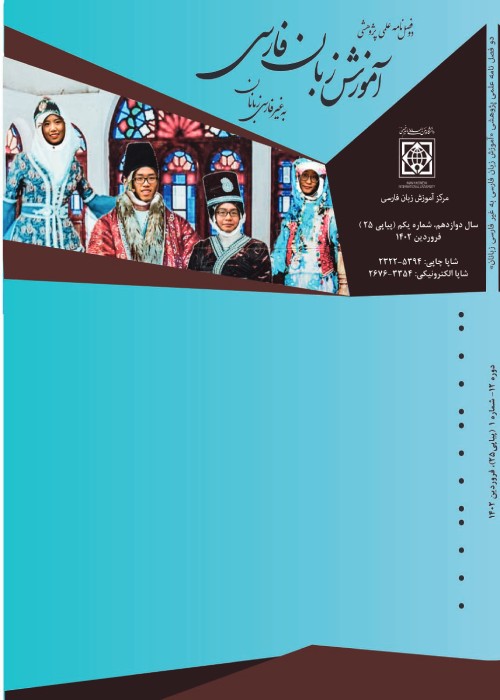Exploring the Speed of Relating Relative Clauses to Heads: A Comparison of Native Persian Speakers and Persian Language Learners
Undoubtedly, mental and conceptual complexities are reflected in the language, as well. Relative clauses are a sample of mental and conceptual complexities which in recent decades,many studies have tried to decode their perception and representation patterns. This topic becomes even more important when it is concerned with teaching language. In the present research, in order to facilitate the teaching of relative clauses, especially to non-native Persian language learners, four kinds of relative clauses including: subject-subject, subject-object, object-object, and object-subject were studied. Perception speed of several forms of each pattern was measured through a computer-based test and twosoftware programs calledMulti Timer Ultimatespeedometerand Snagitscreen capture. The results of the two groups were compared. The data were analyzed through SPSS software (Version 23) and the results indicated that there was no significant difference betweenfour types of relative clauses in terms of perception speed; that is, there wasno relationship between perception speed and the type of relative clause, and both native Persian speakers and Persian language learners can understand these four types of relative clauses at a relatively similar time frame; but the choice of the type was related to being a native Persian speaker or a Persian language learner. Extended Abstract</strong>A reflection of the various mental and conceptual complexities can be found in language. Relative clauses are known as one of the mental and conceptual complexities in various languages around the world. Research on the importance of relative clauses and their typology has received a great deal of attention during the past few decades. Research on relative clauses aimed to decode and reveal linguistic perception patterns in various languages around the world. This type of research is an inseparable part of teaching a language and its results greatly impact the approaches, methods, and techniques used by teachers around the world. In the present research, in order to improve the quality and simplicity of teaching relative clauses to non-native Persian learners, four kinds of relative clauses including: subject-subject, subject-object, object-object, and object-subject were studied. In order to conduct the research, perception speed regarding several forms of each pattern were investigated through a researcher made computer-based test. This computer-based test was designed through the use of two computer softwares, namely, Multi Timer Ultimatespeedometer and Snagitscreen capture. This study utilized a comparative method in order to compare the two groups of participants. The two groups included 32 university students who were studying at Ferdowsi University of Mashhad and 32 advanced non-native Persian learners studying at the International Center for Teaching Persian to Non- Persian Speakers at Ferdowsi University of Mashhad. The advanced non-native Persian learners were all international students who had applied to the Ferdowsi University of Mashhad and had to learn and pass the Persian language courses before gaining admission into their post graduate studies. Each participant was given a written consent form which included the aims of the research and the purpose of investigation, a general description of the study, the task each participant was expected to perform, confidentiality of the test results, and also the right of the participants to withdraw from the study at any point in time. One of the researchers was also present to answer any possible questions that the participants might have. After the consent forms were signed by both the participants and the researchers, a copy of the consent form was given to the participants. The computer test included 8 sentences containing relative clauses 4 of which were the main samples and 4 were confirmatory ones to check the overall perception of the participants. Each participant was asked to sit in front of a computer screen and answer the questions which were displayed on a Microsoft Word file. Multi Timer Ultimate speedometer and Snagitscreen capture were used to pace and monitor the participants’ responses. The speedometer software recorded the time lapse while participants selected the order of sentences and the time difference between comprehending one sentence and moving onto the next sentence was calculated through the use of the recorded times. The Snagitscreen capture was used in order to record the participants’ performance during the test so that each reaction of the participant could be studied further and in more detail after the test. The test included two parts: first, the participants were asked to read each of the 4 sentences in order and to tick which one they understood faster. Multi Timer Ultimate speedometer was used to record how long it took the participant to comprehend the sentences. In the second part of the test, the participants were asked to reorder the sentences based on their understanding, and also elaborate on the reason behind their selected order of sentence placement. The directions in the second part of the computer test pointed out that the order of sentence placement did not have to be the same one as the original sequence selected by the researchers. The collected data was analyzed through the use of SPSS software (Version 23). The most prominent results of the present study included the following: A positive correlation was found between the main and the confirmatory tests regarding all 4 types of relative clauses, namely, subject-subject, subject-object, object-object, and object-subject. This affirms the validity of the collected data. Based on the obtained t-test results, the average speed of perception regarding all 4 types of relative clauses under study, namely, subject-subject, subject-object, object-object, and object-subject The results also indicated that there was no significant difference regarding the perception speed of these four relative clauses; that is, both native Persian speakers and non-native Persian learners can understand these four relative clauses in a relatively similar time frame.
- حق عضویت دریافتی صرف حمایت از نشریات عضو و نگهداری، تکمیل و توسعه مگیران میشود.
- پرداخت حق اشتراک و دانلود مقالات اجازه بازنشر آن در سایر رسانههای چاپی و دیجیتال را به کاربر نمیدهد.



